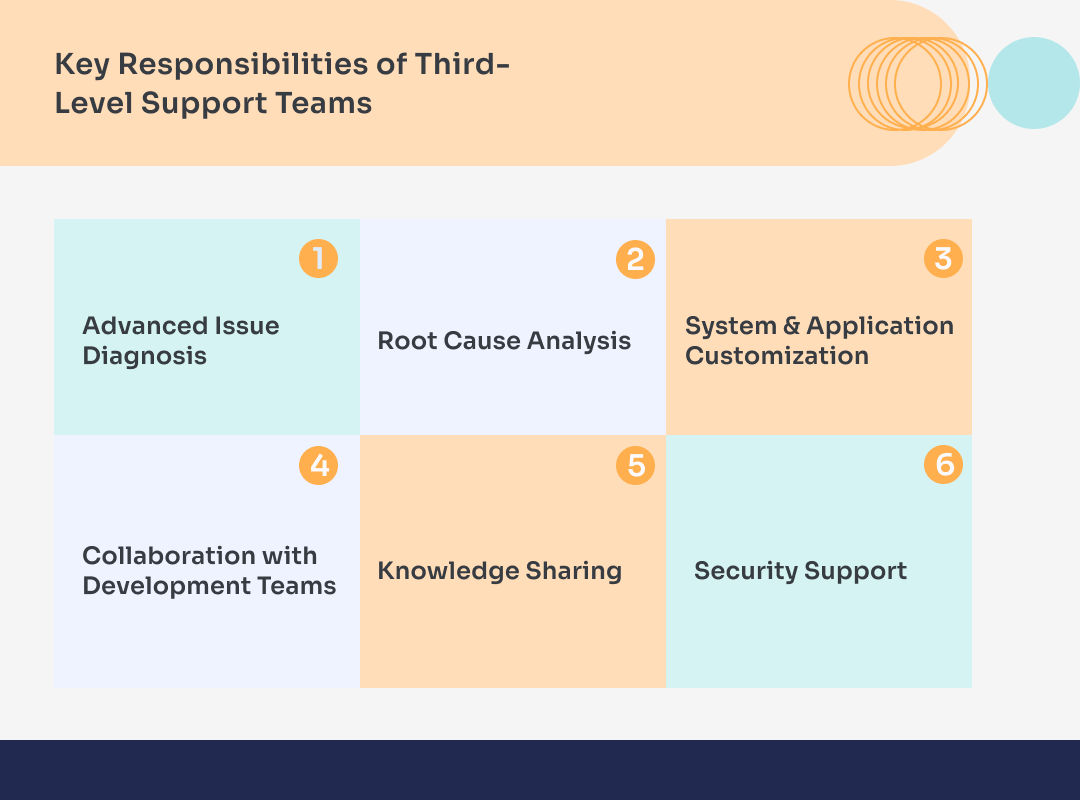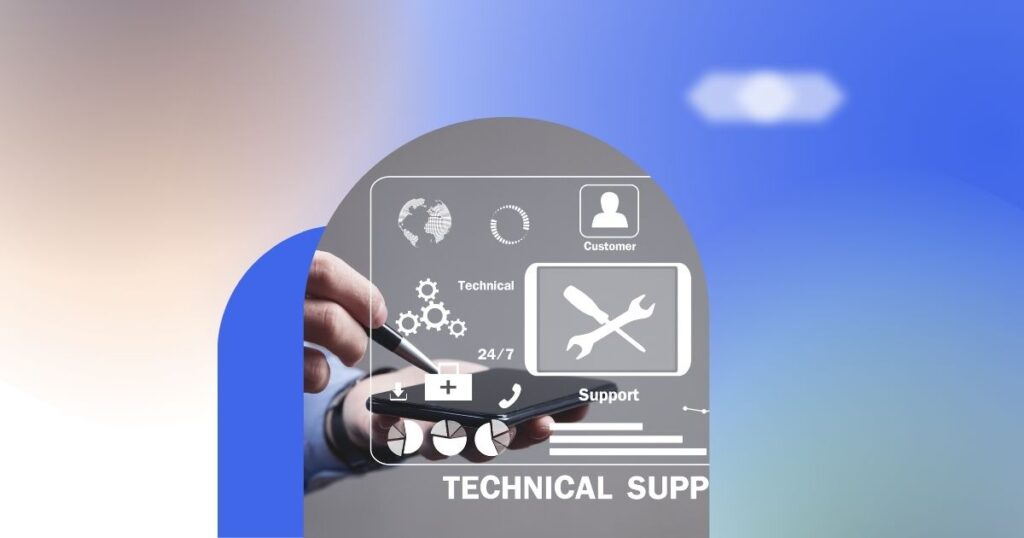Have you ever experienced a complex IT situation that even the best professionals in your IT support team couldn’t solve? As business systems evolve, they will likely become more complex and require the attention of more advanced specialists. This is where third-level support comes in.
Third-level or tier 3 IT support is designed to tackle the most challenging technical problems. Usually, there are three levels of IT support; the first line of support assists with basic troubleshooting issues regarding program and device performance. Second-level support focuses on more in-depth troubleshooting and less common, complex problems. Third-level support, which is the article’s focus, focuses on critical system issues, software failure, security breaches, complex integration issues, etc. It requires deep technical expertise that ensures business systems perform optimally with fewer downtimes.
Access to third-level support expertise is key for business owners, IT managers, and technical teams, as it can smooth operational disruptions and enhance performance. That said, we will explore what third-level support entails, how it differs from other IT support levels, and how it strengthens business operations. You’ll also learn how to leverage Scale Support’s services to access third-level support expertise to drive your business efficiency and ensure long-term stability.
What is Third-Level Support?
Third-level support is mainly required for technical issues beyond basic and common troubleshooting problems. Unlike levels 1 and 2, which deal with basic and intermediate issues, third-level support focuses on the most complex technical problems, from hardware failures to failing network infrastructures.
Level 1 IT support teams deal with password resets, software installation, basic connectivity problems, and other similar issues.
Level 2 IT support addresses systems permissions and access management, network issues, mid-level software troubleshooting, and other similar issues.
Level 3 IT support professionals are the most advanced in the hierarchy. They handle complex software bugs, hardware failures, system crashes, security breaches, advanced troubleshooting, system integration failures, database corruption, etc. In addition to fixing these issues, they perform in-depth analysis to find the root cause and develop long-term solutions to prevent recurrence. Due to the nature of their work, tier 3 IT support specialists often work with software vendors, engineers, and product developers to solve technical issues at their core.
As expected, tier-3 IT support specialists must have deep technical knowledge to work effectively. They often specialise in cloud infrastructure, cybersecurity, enterprise software, etc. They can be senior IT specialists, certified engineers, developers, etc., skilled in using special technologies and operating systems, and have years of quality experience under their belts.
Unlike lower IT support levels, who follow the script, level 3 IT support specialists are more flexible. They can reverse-engineer issues, replicate environments, and innovate solutions to ensure business efficiency.
Key Responsibilities of Third-Level Support Teams
From fixing security breaches to advanced software bugs, third-level support teams have deep technical expertise to tackle the most advanced issues head-on. However, beyond fixing issues, they also engage in knowledge transfer and collaboration. Below is a detailed peek into their key responsibilities:

Advanced Issue Diagnosis
- Third-level support specialists use sophisticated methods to diagnose problems that defy standard troubleshooting. This advanced issue diagnosis enables them to find deep software malfunctions, network bottlenecks, compatibility failures, etc. They combine debugging tools, performance metrics, and replicating the environment to study the problem and get the information they seek.
Root Cause Analysis
- While lower support levels focus on quick fixes, third-level support teams perform a root cause analysis to determine why a problem occurred in the first place. They review user behaviour and system logs, reconstruct the problem scenarios, and document their findings to determine the root cause. This not only helps them develop a tailored solution but also ensures there’s never a recurrence.
System & Application Customization
- Sometimes, there’s a need for solutions beyond what is laid down. This is where third-level support specialists customise applications and systems to solve the problem. They can modify the default configuration, integrate APIs (Application Programming Interfaces), or develop new scripts.
Collaboration with Development Teams
- Another key responsibility of level 3 IT support teams is collaborating with software engineers and product developers to provide feedback, run patch tests before deployment, and solve coding issues. This reduces the likelihood of errors during development and maximises resources as much as possible.
Knowledge Sharing
- Level 3 IT support teams play a key role in knowledge sharing. They document their processes and develop troubleshooting guides for levels 1 and 2 IT support teams. They also train lower-level teams to handle complex issues and update systems with their solutions. This prevents future recurrences of most problems and enhances other team members’ competence.
Security Support
- Due to their advanced training, third-level support specialists can also help ensure security and compliance support. They can identify and remediate security vulnerabilities, ensure the company’s compliance with industry regulations, and recommend infrastructure upgrades to prevent future security incidents.
Third-Level Support vs. First and Second-Level Support
While all levels of IT support fix technical issues, their expertise and scope of responsibilities vary. Understanding these nuances can help you optimise your IT support structure and reach the right specialists when technical issues arise.
First-Level Support
First-level or tier 1 support typically handles basic troubleshooting and routine tasks. These include email setup, password resets, software installation guides, and answering general inquiries. They also use scripted solutions or knowledge base articles. They have basic IT knowledge and customer service skills to attend to users effectively. They respond within minutes and escalate complex issues to second-level support teams.
Second-Level Support
Second-level support, or tier 2 support, provides intermediate technical solutions. Its employees have network expertise and problem-solving skills, making them well-suited to handle software bugs, network connectivity issues, and hardware malfunctions. They can also access advanced diagnostic tools and resolve issues in hours or days.
Third-Level Support
Third-level or tier 3 support teams are the highest in the IT support hierarchy. They are developers, engineers, or specialists who handle the most complex technical issues, such as system failures, security vulnerabilities, code-level bugs, recurring issues, etc. They use root cause analysis and custom scripting methods to resolve technical issues. Sometimes, they collaborate with developers and vendors to develop effective solutions. Depending on the complexity, they can take days or weeks to resolve issues.
| Support Level | Responsibilities | Expertise | Escalation Path | Business Impact |
| First-level | Basic troubleshooting & routine tasks such as password resets, software installation guide, and email setup | Basic IT knowledge
Customer support skills |
General inquiries, user errors, and escalate to the second level if the issue isn’t basic | Minor |
| Second-level | Resolves technical issues such as hardware malfunctions and software errors | Operating system/network expertise | Network connectivity issues, software & hardware diagnostics; escalate deeper issues to the third level | Moderate |
| Third-level | Resolves critical technical issues like system failures, security breaches, code debugging, etc. | Specialises in cloud infrastructure, cybersecurity, etc. | Works with vendors, product developers, and engineers to resolve issues | Critical |
Before an issue can be escalated to tier 3 support, it means it has outgrown tier 1 and tier 2 solutions, affects core business efficiency, or requires an infrastructure or code redesign.
Benefits of Third-Level Support for Businesses
Access to third-level support can mean the difference between a business sinking or thriving when deep technical issues arise. Below is what businesses stand to gain when they invest in third-level support services;
Faster Resolution of Complex Issues through expert-level knowledge
With expertise in cloud infrastructure, database management, and enterprise networks, third-level support specialists can quickly solve the most challenging technical issues. This expertise is more crucial when resolving issues that affect core business operations, such as system crashes or integration failures.
Minimized Downtime by quickly addressing critical incidents
By rapidly addressing critical issues, tier 3 support minimises downtime. They develop immediate workarounds for urgent issues while finding a more permanent solution. They reduce unplanned downtime to the barest minimum, which can mean millions of dollars saved in industries such as healthcare or finance.
Improved System Performance with Proactive Maintenance
Beyond fixing technical issues, third-level support specialists also improve system performance with proactive maintenance. They index your database, balance your server load, and ensure a smooth user experience. They identify and eliminate bottlenecks before they happen, so the business can focus on handling demands seamlessly.
Enhanced Knowledge Base with improved documentation
Every technical issue tier 3 support teams resolve is an opportunity to improve your organisation’s knowledge base. As tier 3 fixes issues, they document their findings, develop troubleshooting guides, and train other IT staff to handle them. This ensures fewer technical issues in the future and a strong IT unit competent to handle most cases.
Stronger Security and Compliance through expert insights
Third-level support teams also help strengthen your security architecture by identifying vulnerabilities, checking compliance, conducting penetration testing, and providing expert insights on improving system security. Their activities reduce the chances of your systems being breached, protecting customers’ information and business reputation.
Strategic IT innovations
Third-level support teams provide insights into how a business can use emerging IT solutions and stay ahead of competitors. They also help companies to plan for more innovative and longer-term IT improvements, making them better positioned to grow and scale.
When to Escalate to Third-Level Support
Knowing when to escalate technical issues to third-level support is highly crucial. Too soon can mean overwhelming these specialists with trivial matters outside their scope, and too late can mean severe downtimes and lost business transactions. When is it right to escalate to tier 3 support?
Persistent software bugs
- If a software bug persists despite multiple troubleshooting attempts or leads to system crashes with no logs, it should be escalated to third-level support. It might be a custom code bug or issue spanning different integrated systems that requires advanced intervention.
Complex infrastructure issues
- Infrastructure issues involving network outages, multiple systems, cloud integration failures, etc., are beyond the scope of the tier 1 and tier 2 support levels. As such, such issues should be escalated to level 3 as soon as they occur.
Security vulnerabilities
- Security vulnerabilities such as compliance-related issues, unusual system behaviour, suspected malware breaches, etc., should be escalated to third-level support specialists. Security issues risk customers’ data and the business reputation, so they must be addressed quickly.
Performance bottlenecks requiring code analysis
- When queries take longer than expected, systems lag with no apparent cause, or applications move slowly under normal loads, you need to escalate to third-level support experts. They will perform a root cause analysis to diagnose the cause of the bottleneck and develop long-lasting solutions to prevent recurrences.
Now that you know when to escalate to third-level support, it’s highly important to know how to do it. Below are some practical steps to follow;
- Document all prior actions: Document all the multiple troubleshooting attempts, logs, screenshots, impact assessments, and error descriptions. This will provide more information about the scope of the issue to third-level support.
- Set clear expectations. Define the severity of the issue to business operations, the number of users affected, and the time elapsed since the issue was detected.
- Establish clear communication protocols – Schedule a briefing with third-level support and hand over the necessary credentials to them. Agree on the timeline for regular updates and designate a point of contact between tier 2 and tier 3 teams to ensure no knowledge is lost.
How ScaleSupport Delivers Expert Third-Level Support
When critical systems fail, business operations are grounded, and thousands of transactions are lost. At ScaleSupport, we provide access to third-level support experts who can help get things back on track.
Our experts are specialised engineers and developers with deep expertise across enterprise-grade systems, cloud infrastructure, and custom software environments. Beyond standard troubleshooting, they deliver strategic, customised solutions for increased system stability. We offer;
24/7 availability and proactive monitoring
Our third-level support experts are on standby to respond to critical issues. They are also proactive and don’t wait for issues to happen. They monitor your systems in real time and set up automated alerts for red flags before they become critical disruptions.
Rapid escalation process
Our rapid escalation framework ensures that escalated issues go to the right person. When an issue reaches our third-level support, we perform a root cause analysis. Then, we develop workarounds to restore business operations while we work to resolve the issue permanently. We document the entire process to increase the knowledge base and minimise recurrences.
By working with us, businesses can enhance their security, reduce downtime, and maintain a flawless user experience, expanding their ability to deliver more value and make more profits.
Conclusion
Whether it’s persistent software bugs or frequent downtimes, businesses need tier 3 IT support experts to resolve these issues quickly. Third-level support isn’t a luxury; it’s necessary for every company with high-performance and complex systems.
As an IT manager, director, or business owner, you need to evaluate your IT team. Are they well-equipped to deal with the complex IT challenges you are facing? Or can they access the required technical knowledge when your business operations are on the line?
When you invest in advanced IT solutions, you gain faster resolutions to IT issues and long-term system stability to prevent disruptions before they occur. This buys your business time to expand your infrastructure to grow and scale. However, not all IT service providers offer third-level support. You need to consider the technical specialisation in your industry, track record of providing scalable solutions, and real-time communication.
At ScaleSupport, we combine third-level support experts, proactive monitoring, and rapid escalation protocols to deliver the most needed solutions. Explore our services to see how we solve the toughest IT challenges. However, if you prefer tailor-made solutions, schedule a free consultation and let’s discuss your business needs first.

Dianne has extensive experience as a Content Writer, she creates engaging content that captivates readers and ranks well online. She stays on top of industry trends to keep her work fresh and impactful. She has a talent for turning complex ideas into relatable stories. When she’s not writing, you’ll probably find her with a crochet hook in hand or working on a fun craft project. She loves bringing creativity to life, whether it’s through words or handmade creations.






